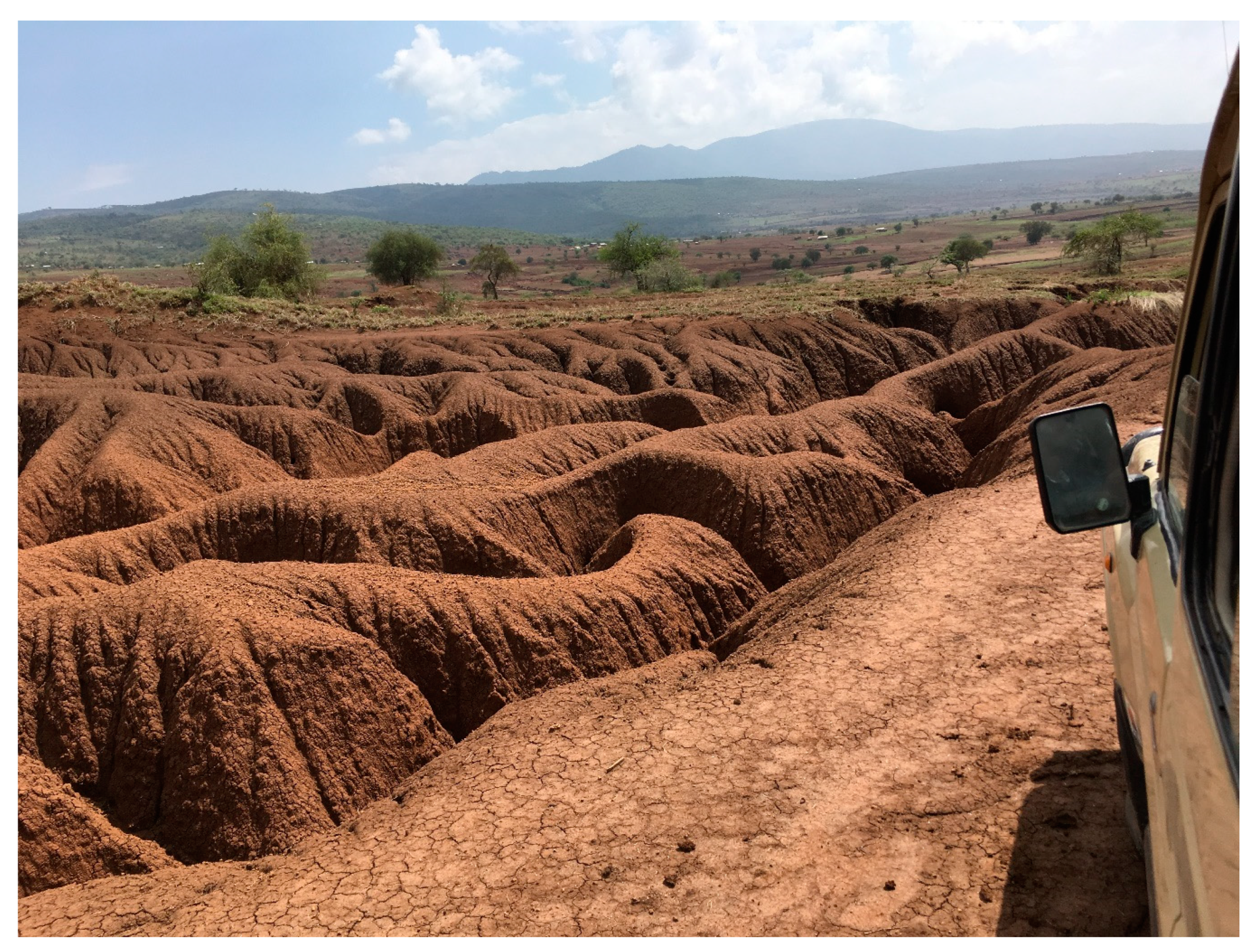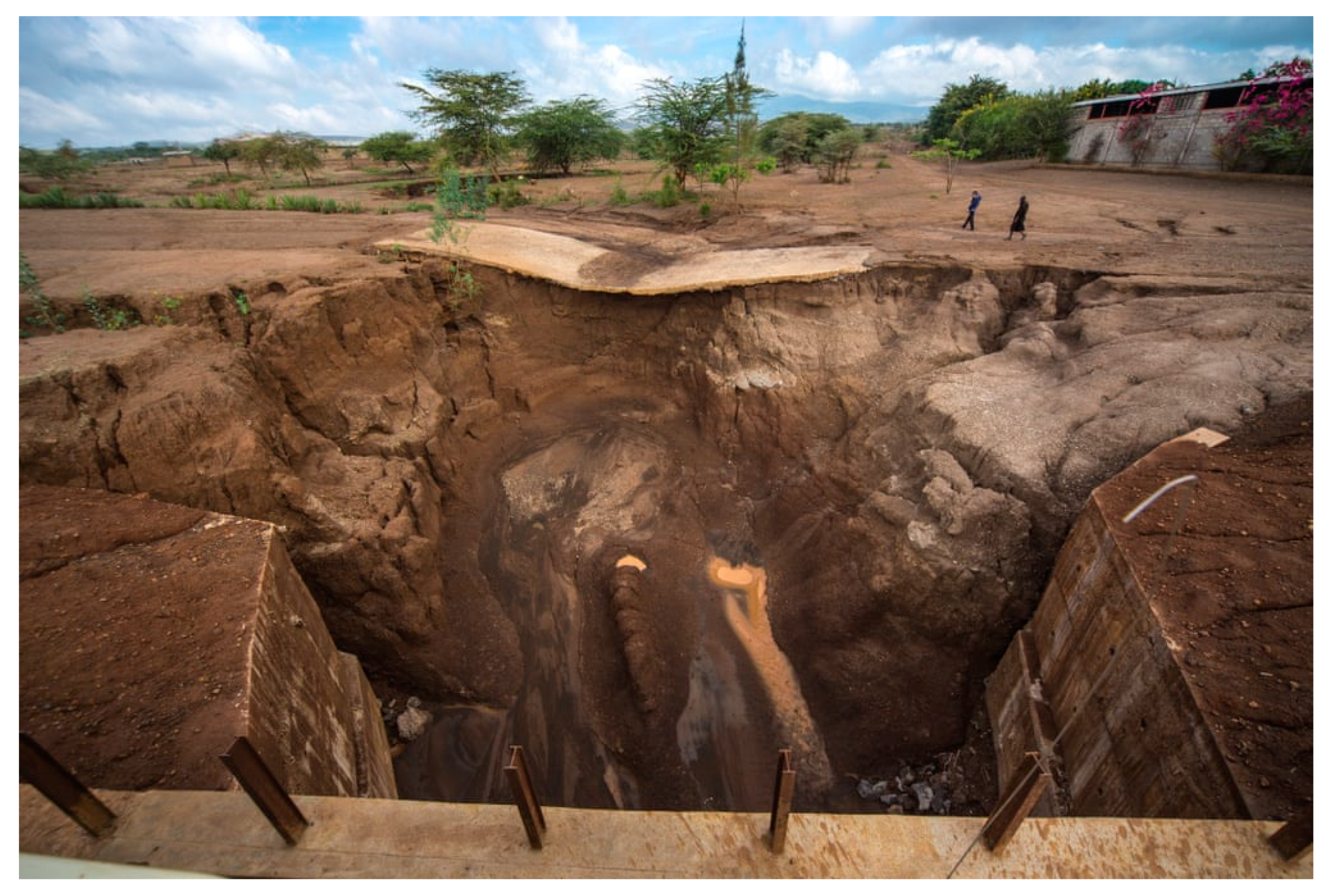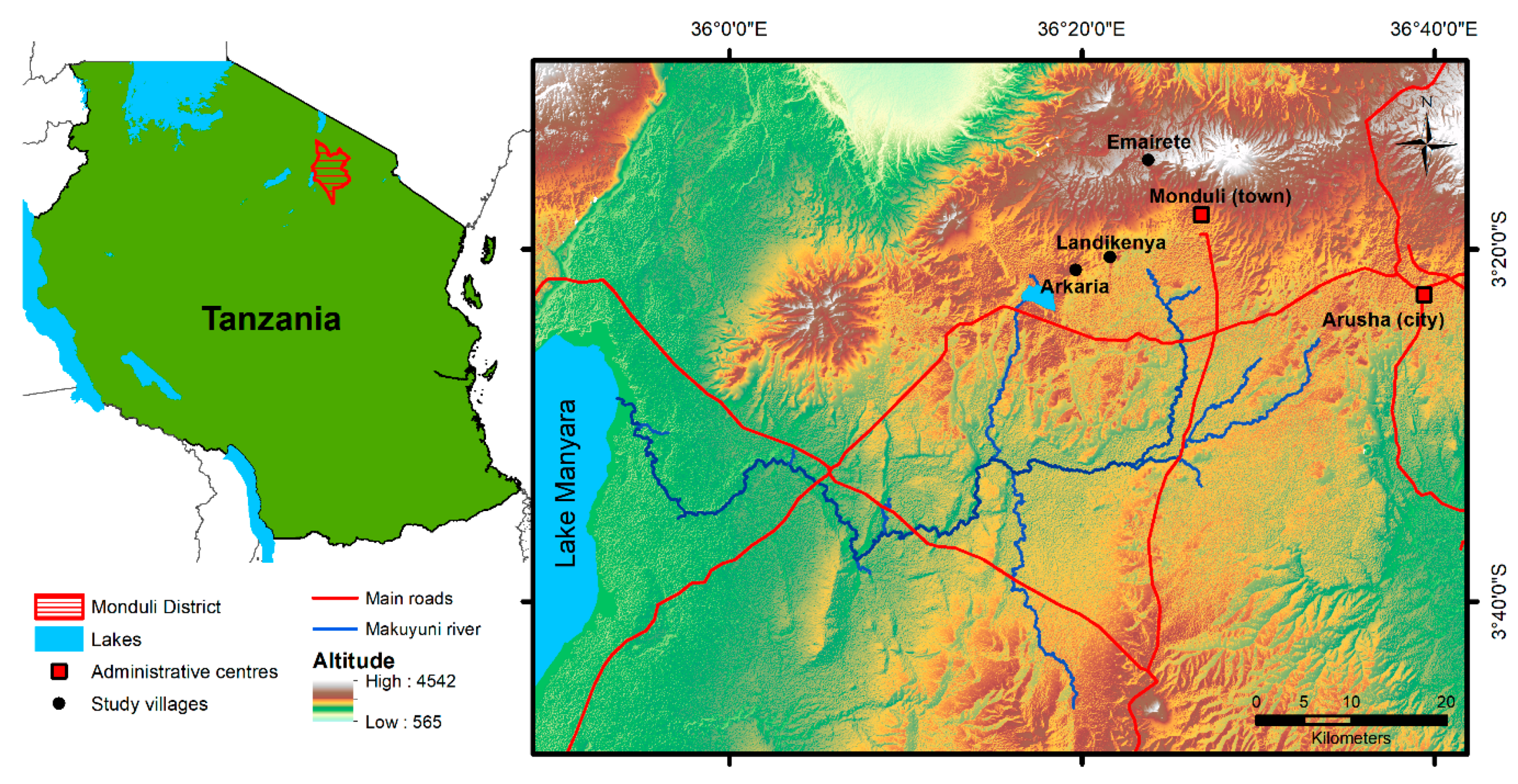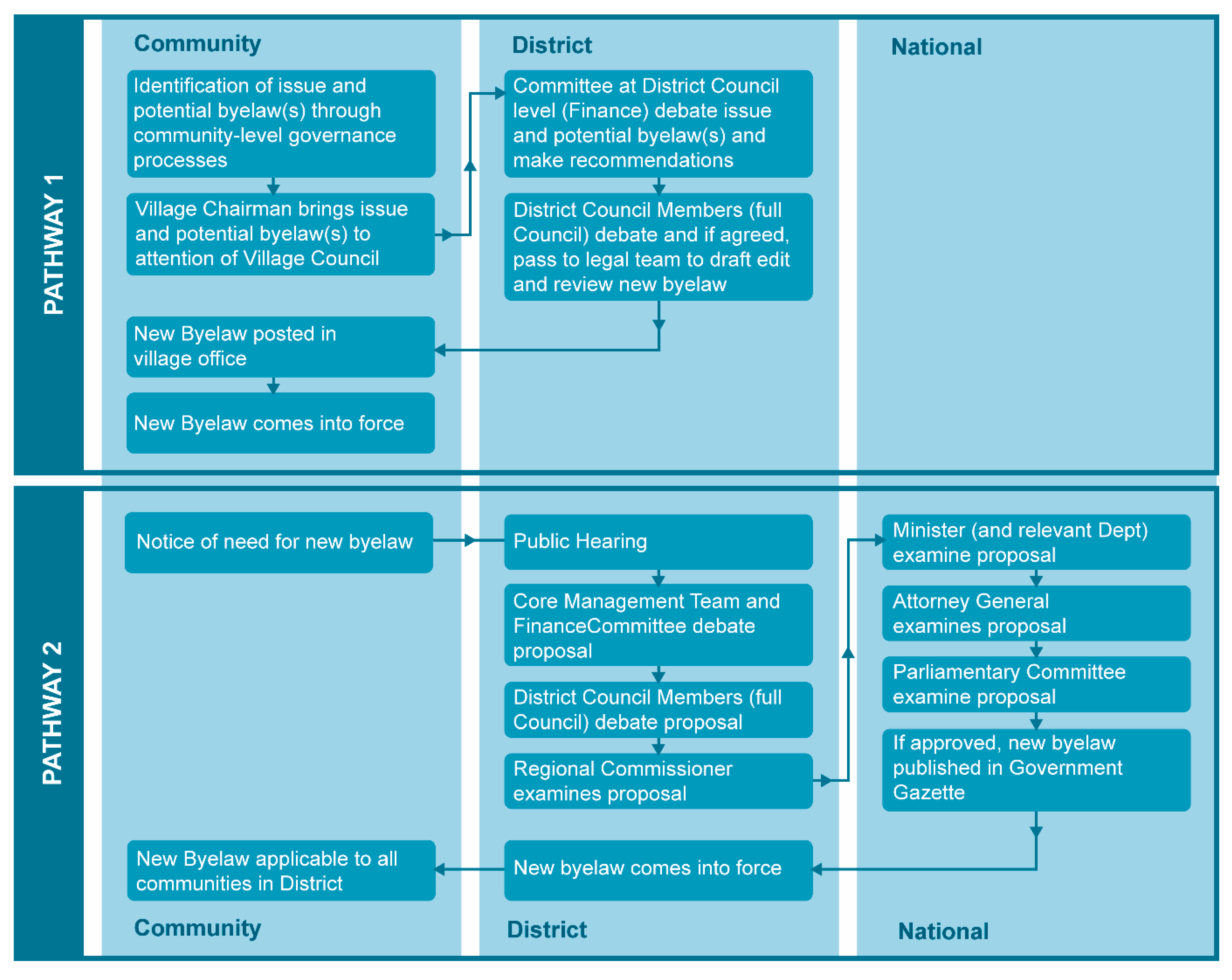‘Mind the Gap’: Reconnecting Local Actions and Multi-Level Policies to Bridge the Governance Gap. An Example of Soil Erosion Action from East Africa
Abstract
:1. Introduction
The Tanzanian Governance Context
2. Materials and Methods
2.1. Case Study Context
- Information (training in sustainable agriculture; terrace construction; contour farming; soil management; tree and shrub planting);
- Policies (new byelaws; better monitoring and enforcement of existing byelaws; land use planning and zoning); and
- Resources (Agricultural Extension Workers; locally appropriate tree species; better roads and trackways to avoid run off and erosion).
- Deal with existing erosion issues,
- Develop sustainable land management strategies, and
- Ensure legitimacy though existing governance processes.
2.2. Workshop Context and Follow-Up Interviews
3. Results
3.1. Governance Challenges
- To prevent forest and scrub clearance. Policy instruments were requested to control felling of trees and cutting branches for firewood and other uses.
- To ensure conservation farming measures were implemented in upland areas, including contour ploughing, terrace construction and maintenance, and water run-off management in upland and upslope areas, to prevent erosion further downslope.
- To prevent existing trackways becoming new gullies.
- To create and better manage livestock grazing zones to prevent uncontrolled and overuse of key areas prone to erosion and enable vegetation recovery and land cover during drought.
3.2. Practical Challenges
3.3. Wider Issues
- Distance. The villages nearest to tarmac roads were often the ones approached first to participate in research, support or training, whilst those further from good roads were less likely to be chosen, leading to a sense of being forgotten, and slower in terms of development.
- Purpose. Many initiatives included multiple objectives which were not always integrated—for example, child care and environmental conservation. Villagers were unclear on what actions they should focus on, resulting in failure across all actions.
- Follow up. Where initiatives were brought to the village, they were often not effectively followed up, hence failing to achieve any medium- or long-term objectives. Allied to this was a lack of feedback to the community, with no information on whether the project as a whole had failed or what lessons the community could learn from the outcomes.
4. Discussion
4.1. Fragmented Governance Approaches
4.2. Closing the Governance Gap
5. Conclusions
Author Contributions
Funding
Acknowledgments
Conflicts of Interest
Appendix A


| Time | Action | Format | Details |
|---|---|---|---|
| 9 am–9:30 am | Arrival Tea/Coffee | All together | Guide participants to tables (Note: every village has its own designated table) |
| 9:30 am–10 am | Welcome/Brief introduction to project and team | All together |
|
| 10 am–12 pm | Activity 1: What do we have; information, resources, policies? | Village-specific round table discussion—1 table for each villageFacilitators recount discussion summary from each community back to all | Each table consists of:
|
| 12 pm–1 pm | Lunch | ||
| 1 pm–2:30 pm | Activity 2: What do we need; start-stop-keep? | Village-specific round table discussion—1 table for each village Facilitators recount discussion summary from each community back to all | This exercise is a combination of group discussion and individual work Following the morning discussion, the facilitators and champions encourage participants to note down what (information, resources, and policies) they would keep, what existing things they think need to stop and what new actions they think should start During lunch break, facilitator assistants will help team to capture the emerging themes from the morning discussions to keep the afternoon exercise focused on actual specifics |
| 2:30 pm–3 pm | Sharing ideas and committing to action | All together | Feedback and discussion led by facilitators; individuals are invited to share actions they will take in the next two weeks, two months, and two years |
| 3 pm–4 pm | Gifts Tea/Coffee | All together | Thanks, future plans and goodbye |
| INFORMATION AND RESOURCES Information needs
Resource needs
|
| TRAINING Available training
Has training been effective?Most trainings into the village haven’t been effective due to the following reasons:
Things needed to implement the techniques learned;
|
| POLICY Existing land management policies
Suggested byelaws
Are these byelaws implementable?
|
References
- Blaikie, P. Land Degradation and Society; Blaikie, P., Brookfield, H., Eds.; Methuen: London, UK, 1987; p. 296. [Google Scholar]
- Wilson, G.A.; Juntti, M. (Eds.) Unravelling Desertification: Policies and Actor Networks in Southern Europe; Wageningen Academic Publishers: Wageningen, The Netherlands, 2005; p. 246. [Google Scholar]
- Brockington, D. Fortress Conservation: The Preservation of the Mkomazi Game Reserve, Tanzania; Indiana University Press: Bloomington, IN, USA, 2002. [Google Scholar]
- Briassoulis, H. Governing Desertification in Mediterranean Europe: The challenge of Environmental Policy Integration in Multi-Level Governance Contexts. Land Degrad. Dev. 2011, 22, 313–325. [Google Scholar] [CrossRef]
- Kelly, C.; Ferrara, A.; Wilson, G.A.; Ripullone, F.; Nolè, A.; Harmer, N.; Salvati, L. Community Resilience and Land Degradation in Forest and Shrubland Socio-Ecological Systems: Evidence from Gorgoglione, Basilicata, Italy. Land Use Policy 2015, 46, 11–20. [Google Scholar] [CrossRef] [Green Version]
- Pretty, J. Participatory Learning for Sustainable Agriculture. World Dev. 1995, 23, 1247–1263. [Google Scholar] [CrossRef]
- Pretty, J.N. Agri-Culture: Reconnecting People, Land and Nature; Earthscan: London, UK, 2002. [Google Scholar]
- Díaz, S.; Demissew, S.; Carabias, J.; Joly, C.; Lonsdale, M.; Ash, N.; Larigauderie, A.; Adhikari, J.R.; Arico, S.; Báldi, A.; et al. The IPBES Conceptual Framework—Connecting Nature and People. Curr. Opin. Environ. Sustain. 2015, 14, 1–16. [Google Scholar] [CrossRef] [Green Version]
- FAO. Status of the World’s Soil Resources: Main Report; Food and Agriculture Organisation of the United Nations, ITPS, Global Soil Partnership: Rome, Italy, 2015. [Google Scholar]
- Borrelli, P.; Robinson, D.A.; Fleischer, L.R.; Lugato, E.; Ballabio, C.; Alewell, C.; Meusburger, K.; Modugno, S.; Schütt, B.; Ferro, V.; et al. An assessment of the global impact of 21st century land use change on soil erosion. Nat. Commun. 2017, 8, 2013. [Google Scholar] [CrossRef] [PubMed] [Green Version]
- Blaikie, P. Changing environments or changing views? A political ecology for developing countries. Geography 1995, 80, 203–214. [Google Scholar]
- Smit, H.; Muche, R.; Ahlers, R.; Zaag, P. The Political Morphology of Drainage—How Gully Formation Links to State Formation in the Choke Mountains of Ethiopia. World Dev. 2017, 98, 231–244. [Google Scholar] [CrossRef]
- Blake, W.H.; Rabinovich, A.; Wynants, M.; Ndakidemi, P. Soil erosion in East Africa: An interdisciplinary approach to realising pastoral land management change. Environ. Res. Lett. 2018, 13, 124014. [Google Scholar] [CrossRef] [Green Version]
- Mazzocchi, F. Western science and traditional knowledge. Despite their variations, different forms of knowledge can learn from each other. EMBO Rep. 2006, 7, 463–466. [Google Scholar] [CrossRef] [Green Version]
- Wilson, G.A.; Kelly, C.L.; Briassoulis, H.; Ferrara, A.; Quaranta, G.; Salvia, R.; Detsis, V.; Curfs, M.; Cerda, A.; El-Aich, A.; et al. Social Memory and the Resilience of Communities Affected by Land Degradation. Land Degrad. Dev. 2017, 28, 383–400. [Google Scholar] [CrossRef]
- Wynants, M.; Kelly, C.; Mtei, K.; Munishi, L.; Patrick, A.; Rabinovich, A.; Nasseri, M.; Gilvear, D.; Roberts, N.; Boeckx, P. Drivers of increased soil erosion in East Africa’s agro-pastoral systems: Changing interactions between the social, economic and natural domains. Reg. Environ. Change 2019, 19, 1–13. [Google Scholar]
- Habtezion, S.; Adelekan, I.; Aiyede, E.; Biermann, F.; Fubara, M.; Gordon, C.; Gyekye, K.; Kasimbazi, E.; Kibugi, R.; Lawson, E.; et al. Earth System Governance in Africa: Knowledge and capacity needs. Curr. Opin. Environ. Sustain. 2015, 14, 198–205. [Google Scholar] [CrossRef]
- Rabinovich, A.; Kelly, C.; Wilson, G.; Nasseri, M.; Ngondya, I.; Patrick, A.; Blake, W.H.; Mtei, K.; Munishi, K.; Munishi, L.; et al. “We will change whether we want it or not”: Soil erosion in Maasai land as a social dilemma and a challenge to community resilience. J. Environ. Psychol. 2019, 66, 101365. [Google Scholar] [CrossRef]
- Mamdani, M. Citizen and subject: Contemporary Africa and the Legacy of Late Colonialism; Princeton University Press: Princeton, NJ, USA, 2018. [Google Scholar]
- Snyder, K.A. Agrarian change and land-use strategies among Iraqw farmers in northern Tanzania. Hum. Ecol. 1996, 24, 315–340. [Google Scholar] [CrossRef]
- Diaw, M.C. Social and Production Relationships in the Artisanal Maritime Fisheries of West Afrcia: A Comparative Analysis; Michigan State University: Lansing, MI, USA, 1983. [Google Scholar]
- Kjekshus, H. Ecology Control & Economic Development in East African History: The Case of Tanganyika 1850–1950; Ohio University Press: Athens, OH, USA, 1996. [Google Scholar]
- Anderson, D. Depression, dust bowl, demography, and drought: The colonial state and soil conservation in East Africa during the 1930s. Afr. Aff. 1984, 83, 321–343. [Google Scholar] [CrossRef]
- Smith, C.D. Did Colonialism Capture the Peasantry: A Case Study of the Kagera District, Tanzania; Nordic Africa Institute: Uppsala, Sweden, 1989. [Google Scholar]
- Huijzendveld, F.D. Changes in political economy and ecology in West-Usambara, Tanzania: Ca. 1850–1950. Int. J. Afr. Hist. Stud. 2008, 41, 383–409. [Google Scholar]
- Monson, J. Relocating Maji Maji: The politics of alliance and authority in the southern highlands of Tanzania, 1870–1918. J. Afr. Hist. 1998, 39, 95–120. [Google Scholar] [CrossRef]
- Lovett, J.; Quinn, C.; Kiwasila, H.; Stevenson, S.; Pallangyo, N.; Muganga, C. Overview of Common Pool Resource Management in Semi-Arid Tanzania; Centre for Ecology, Law and Policy, University of York: Heslington, UK, 2001. [Google Scholar]
- Burton, A.; Jennings, M. Introduction: The emperor’s new clothes? Continuities in governance in late colonial and early postcolonial East Africa. Int. J. Afr. Hist. Stud. 2007, 40, 1–25. [Google Scholar]
- Mung’ong’o, C.; Loiske, V. Structural Adjustment Programmes and Peasant Responses in Tanzania; Pluto Press: London, UK, 1995. [Google Scholar]
- Cliffe, L.R. Nationalism and the reaction to enforced agricultural change in Tanzania during the Colonial period. Taamuli 1970, 1, 3–15. [Google Scholar]
- Jennings, M. A Very Real War: Popular Participation in Development in Tanzania During the 1950s & 1960s. Int. J. Afr. Hist. Stud. 2007, 40, 71–95. [Google Scholar]
- Kjekshus, H. The Tanzanian villagization policy: Implementational lessons and ecological dimensions. Can. J. Afr. Stud. Rev. Can. Des Études Afr. 1977, 11, 269–282. [Google Scholar]
- Boesen, J. Tanzania-From Ujamaa to Villagization; Institute for Development Research: Bochum, Germany, 1976. [Google Scholar]
- Hydén, G. Beyond Ujamaa in Tanzania: Underdevelopment and an Uncaptured Peasantry; University of California Press: Berkeley, VA, USA, 1980. [Google Scholar]
- Lawi, Y.Q. Tanzania’s Operation Vijiji and Local Ecological Consciousness: The Case of Eastern Iraqwland, 1974–1976. J. Afr. Hist. 2007, 48, 69–93. [Google Scholar] [CrossRef]
- Kikula, I.S. Policy Implications on Environment: The Case of Villagisation in Tanzania; Nordic Africa Institute: Uppsala, Sweden, 1997. [Google Scholar]
- Coulson, A. Agricultural Policies in Mainland Tanzania, 1946–1976. In Rural Development in Tropical Africa; Springer: Berlin/Heidelberg, Germany, 1981; pp. 52–89. [Google Scholar]
- Heald, S. State, law, and vigilantism in northern Tanzania. Afr. Aff. 2005, 105, 265–283. [Google Scholar] [CrossRef]
- Coldham, S. Land tenure reform in Tanzania: Legal problems and perspectives. J. Mod. Afr. Stud. 1995, 33, 227–242. [Google Scholar] [CrossRef]
- Sendalo, D. A Review of Land Tenure Policy Implications on Pastoralism in Tanzania; Ministry of Livestock Development and Fisheries: Dar es Salaam, Tanzania, 2009. [Google Scholar]
- United Republic of Tanzania. National Land Policy 2; Surveys and Mapping: Dar es Salaam, Tanzania, 1997. [Google Scholar]
- Lane, C.R.; Pretty, J.N. Displaced Pastoralists and Transferred Wheat Technology in Tanzania; IIED, International Institute for Environment and Development: London, UK, 1990. [Google Scholar]
- Homewood, K.; Coast, E.; Thompson, M. In-Migrants and Exclusion in East African Rangelands: Access, Tenure and Conflict. Africa 2004, 74, 567–610. [Google Scholar] [CrossRef]
- Odgaard, R. Scrambling for land in Tanzania: Processes of formalisation and legitimisation of land rights. Eur. J. Dev. Res. 2002, 14, 71–88. [Google Scholar] [CrossRef]
- John, P.; Kabote, S.J. Land Governance and Conflict Management in Tanzania: Institutional Capacity and Policy-Legal Framework Challenges. Am. J. Rural Dev. 2017, 5, 46–54. [Google Scholar] [CrossRef] [Green Version]
- Bluwstein, J.; Lund, J.F.; Askew, K.; Stein, H.; Noe, C.; Odgaard, R.; Maganga, F.P.; Engström, L. Between dependence and deprivation: The interlocking nature of land alienation in Tanzania. J. Agrar. Chang. 2018, 18, 806–830. [Google Scholar] [CrossRef]
- African Union. Policy Framework for Pastoralism in Africa: Securing, Protecting and Improving the Lives, Livelihoods and Rights of Pastoralist Communities; African Union: Addis Ababa, Ethiopia, 2010. [Google Scholar]
- Hodgson, D.L. Being Maasai, Becoming Indigenous: Postcolonial Politics in a Neoliberal World; Indiana University Press: Bloomington, IN, USA, 2011. [Google Scholar]
- Beierle, T.C.; Cayford, J. Democracy in Practice: Public Participation in Environmental Decisions; Resources for the Future: Washington, DC, USA, 2002. [Google Scholar]
- Tracy, S.J. Qualitative Quality: Eight “Big-Tent” Criteria for Excellent Qualitative Research. Qual. Inq. 2010, 16, 837–851. [Google Scholar] [CrossRef] [Green Version]
- Wynants, M.; Solomon, H.; Ndakidemi, P.; Blake, W.H. Pinpointing areas of increased soil erosion risk following land cover change in the Lake Manyara catchment, Tanzania. Int. J. Appl. Earth Obs. Geoinf. 2018, 71, 1–8. [Google Scholar] [CrossRef]
- Karger, D.N.; Conrad, O.; Böhner, J.; Kawohl, T.; Kreft, H.; Soria-Auza, R.W.; Zimmermann, N.E.; Linder, H.P.; Kessler, M. Climatologies at high resolution for the earth’s land surface areas. Sci. Data 2017, 4, 170122. [Google Scholar] [CrossRef] [PubMed] [Green Version]
- Prins, H.H.T.; Loth, P.E. Rainfall Patterns as Background to Plant Phenology in Northern Tanzania. J. Biogeogr. 1988, 15, 451–463. [Google Scholar] [CrossRef]
- Nicholson, S.E. The nature of rainfall variability over Africa on time scales of decades to millenia. Glob. Planet. Chang. 2000, 26, 137–158. [Google Scholar] [CrossRef]
- TSED. Census 2012. Available online: http://www.dataforall.org/tanzania/ (accessed on 21 September 2020).
- Blomley, T.; Iddi, S. Participatory Forest Management in Tanzania; Lessons Learned and Experiences to Date; Tourism, M.O.N.R.A., Ed.; United Republic of Tanzania: Dar es Salaam, Tanzania, 2009. [Google Scholar]
- Blomley, T.; Ramadhani, H. Going to scale with Participatory Forest Management: Early lessons from Tanzania. Int. For. Rev. 2006, 8, 93–100. [Google Scholar] [CrossRef]
- Homewood, K.; Trench, P.C.; Kristjanson, P. Pastoral Livelihoods, Diversification and the Role of Wildlife in Development. In Staying Maasai; Springer: Berlin/Heidelberg, Germany, 2009; pp. 369–408. [Google Scholar]
- nited Republic of Tanzania. United Republic of Tanzania Fifth National Report on Implementation of the Convention of Biological Diversity; United Republic of Tanzania: Dar es Salaam, Tanzania, 2014. [Google Scholar]
- Enfors, E.I.; Gordon, L.J. Analysing resilience in dryland agro-ecosystems: A case study of the Makanya catchment in Tanzania over the past 50 years. Land Degrad. Dev. 2007, 18, 680–696. [Google Scholar] [CrossRef]
- Alden Wily, L. Forest law in eastern and southern Africa: Moving towards a community-based forest future? Unasylva 2000, 51, 19–26. [Google Scholar]
- Alden Wily, L.; Dewees, P.A. From Users to Custodians: Changing Relations between People and the State in Forest Management in Tanzania; The World Bank: Washington, DC, USA, 2001. [Google Scholar]
- Hamza, K.; Kimwer, E. Tanzania’s forest policy and its practical achievements with respect to community based forest management in MITMIOMBO. For. Res. 2007, 24–33. [Google Scholar]
- Hogan, R.; Mwambeso, P.A.; Nandi, R.X.L.; Elbariki, R.; Chande, M.O. Rural community capacity-building through increasing local control over forest resources—The case of Tanzania through the example of village communities in Rufiji district. Small Scale For. Rural Dev. Intersect. Ecosyst. Econ. Soc. 1999, 164–177. [Google Scholar]
- Homewood, K.; Kristjanson, P.; Trench, P. Livelihoods, conservation and development in East African rangelands. In Staying Maasai; Springer: Berlin/Heidelberg, Germany, 2009; Volume 5. [Google Scholar]


© 2020 by the authors. Licensee MDPI, Basel, Switzerland. This article is an open access article distributed under the terms and conditions of the Creative Commons Attribution (CC BY) license (http://creativecommons.org/licenses/by/4.0/).
Share and Cite
Kelly, C.; Wynants, M.; Munishi, L.K.; Nasseri, M.; Patrick, A.; Mtei, K.M.; Mkilema, F.; Rabinovich, A.; Gilvear, D.; Wilson, G.; et al. ‘Mind the Gap’: Reconnecting Local Actions and Multi-Level Policies to Bridge the Governance Gap. An Example of Soil Erosion Action from East Africa. Land 2020, 9, 352. https://doi.org/10.3390/land9100352
Kelly C, Wynants M, Munishi LK, Nasseri M, Patrick A, Mtei KM, Mkilema F, Rabinovich A, Gilvear D, Wilson G, et al. ‘Mind the Gap’: Reconnecting Local Actions and Multi-Level Policies to Bridge the Governance Gap. An Example of Soil Erosion Action from East Africa. Land. 2020; 9(10):352. https://doi.org/10.3390/land9100352
Chicago/Turabian StyleKelly, Claire, Maarten Wynants, Linus K. Munishi, Mona Nasseri, Aloyce Patrick, Kelvin M. Mtei, Francis Mkilema, Anna Rabinovich, David Gilvear, Geoff Wilson, and et al. 2020. "‘Mind the Gap’: Reconnecting Local Actions and Multi-Level Policies to Bridge the Governance Gap. An Example of Soil Erosion Action from East Africa" Land 9, no. 10: 352. https://doi.org/10.3390/land9100352






